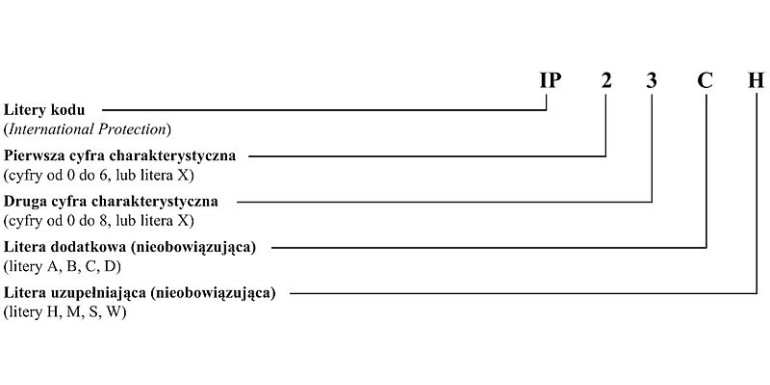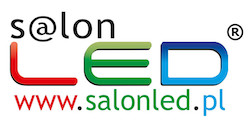-
How to create zone lighting using magnetic tracks? 12/08/2025 14:04:06How to choose the right light color in track lighting? 12/01/2025 14:46:21What is indirect light and why is it fashionable? 11/19/2025 18:37:52IP marking - what it is02/12/2019 12:59:24

Renovation or home or flat furnishing involves the purchase of various types of equipment. You need electrical products such as sockets, connectors and lamps, as well as accessories associated with them. All devices have specific markings that tell a lot about their properties. LED lighting also has some markings. Contrary to appearances, understanding what these symbols suggest is not so difficult.
IP is a symbol that we encounter in the case of various electrical devices. These two letters are an abbreviation from English. The full IP name is: International Protection Rating. Speaking in simple words? IP is an international indication of the degree of protection of a given device against external factors: solids and water. The degree of protection can also be described as a tightness class. The designation always consists of the same letters or IP and the following two digits.
Degrees of protection against solid objects are as follows:
0 - the device has no protection
1 - protection at a low level, protects only against large foreign objects, whose diameter exceeds 50 mm, which means that it protects against accidental touch with the hand
2 - protection against foreign objects with a diameter of more than 12 mm, protection against accidental contact, e.g. fingers
3 - protection against small foreign objects over 2.5 mm in diameter means protection against accidental contact with wire or screwdriver
4 - protection against small foreign objects, whose diameter exceeds 1 mm, before cables, thin tools
5 - protection against very small foreign objects such as dust, but it is not 100% protection, it protects against dust to a reasonable extent
6 - protection at the highest level, provides complete protection against the ingress of dust
Degrees of protection against water are presented as:
0 - the device has no protection
1 - protection against dripping water vertically
2 - protection against drops of water that fall on the device at an angle of no more than 15 degrees
3 - protection against water droplets that fall on the device at an angle of no more than 60 degrees
4 - protection against water dripping from different directions, effective protection against rain
5 - protection against water flow regardless of the angle of its incidence
6 - protection against a strong water jet regardless of the angle of its operation
7 - the device can even be immersed in water, but not for long and not deep, while these rules will prevent the water from entering the interior
8 - protection against penetration of water into the device under long-term immersion up to 1 m deep
9 - protection against a strong water jets at pressures up to 100 bar and temperatures up to 80 ° CElements such as ceiling luminaires or incandescent lamps may have different sealing classes. Our products show signs of low protection, eg IP20, as well as signs guaranteeing effective protection, an example of which is bathroom lighting. Below we present an explanation of specific protection levels that most often appear in the descriptions of our goods.
The product with the IP20 marking has a degree of protection against the penetration of foreign bodies at level 2. It is not therefore well protected against the impact of foreign objects. All materials whose size is equal to or less than 12 mm can penetrate inside the device. The device is resistant to touch in the first place. It will not be damaged under the touch of your fingers. The degree of protection against water is at level 0, which means that it is not protected against water in any way.
The IP44 marking is tantamount to the degree of protection against foreign objects on level 4. Looking at the description of individual protection levels described earlier, we can read that the product is protected against penetration into the interior of small foreign bodies such as thin wires and tools. Anything equal to or less than 1 mm can penetrate inside the device. The level of protection against water is also 4. The fourth tightness class provides protection against water striking the object from different directions. In the case of articles mounted outdoors, you can be sure that the rain will not damage the structure.
In the case of IP 54, the degree of protection against the penetration of foreign bodies is at level 5. This is a high degree of tightness, which prevents the penetration of such fine material as dust. Provides protection against dust, which likes to gather in different places. However, it should be remembered that in a very dusty place, if, for example, the device would have constant contact with sand, protection would not be enough. IP54 and IP44 have the same level of protection against water, which is equal to 4. The protection is so effective that the water does not get into the interior when the product is pouring from different sides. The rain will not penetrate inside.
You can also see the IP65 marking on the products. Protection against foreign objects at level 6 is the highest possible level of protection. There is no right to get inside the device. The product is protected even against very intense dust particles. The number 5 informs that the device has a high water resistance. Irrespective of the angle at which the water jet works, the protection does not allow even a drop of water to penetrate. However, it would not withstand the really strong stream.
The higher the numbers in the determinations, the better the protection level. In the case of IP67, again we deal with protection against foreign objects at level 6, which is the highest degree of protection. The device has no right to penetrate the smallest dust - even if it was all covered with it. Digit 7 informs about a very high level of protection against the factor of water. A product with this designation can even be placed in water, but it is only for short-term immersion to a small depth.
Menu
- +Outdoor lighting
- +Indoor lighting
- +Wall LED lamps
- Line light LED
- LED profiles ALU
- +Track system
- +LED ceiling lamps, hanging and surface-mounted
- +Ceiling covers
- Starry Sky
- +LED plafonds
- LED recessed downlights
- +Hanging lamps LED
- Ceiling spotlights and spots
- Ceiling fans LED
- LED lights for paintings
- +LED floor lamps
- LED table and desk lamps
- Living room
- Bedroom
- Dining room
- LED bathroom lighting
- LED kitchen lighting
- LED stairs lighting
- +LED bulbs
- All manufacturers
- Prices drop
- New Products
- Bestseller




